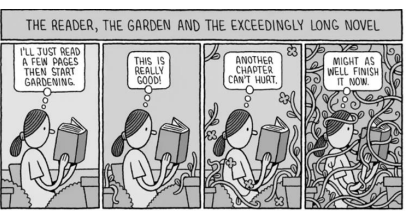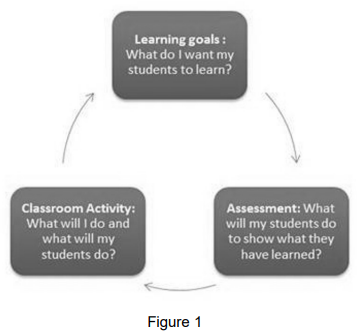Questões de Concurso
Sobre advérbios e conjunções | adverbs and conjunctions em inglês
Foram encontradas 555 questões
Text III

From: https://streetlibrary.org.au/reading-in-the-garden-tom-gauld-cartoon/
TEXT 1
Why is music good for the brain?
October 7, 2020
By Andrew E. Budson, MD, Editorial Advisory Board Member, Harvard Health Publishing

1. Can music really affect your well-being, learning, cognitive function, quality of life, and even happiness? Hand in a recent survey on music and brain health conducted by AARP revealed some interesting findings about the impact of music on cognitive and emotional well-being: music listeners had higher scores for mental well-being and slightly reduced levels of anxiety and depression compared to people overall.
2. Of survey respondents who currently go to musical performances, 69% rated their brain health as “excellent” or “very good,” compared to 58% for those who went in the past and 52% for those who never attended. Of those who reported often being exposed to music as a child, 68% rated their ability to learn new things as “excellent” or “very good,” compared to 50% of those who were not exposed to music.
3. Active musical engagement, including those over age 50, was associated with higher rates of happiness and good cognitive function. Adults with no early music exposure but who currently engage in some music appreciation show above average mental well-being scores. Those are pretty impressive results, to be sure. However, this 20-minute online survey has some limitations. For one, it included 3,185 US adults ages 18 and older; that is a small number if you are extrapolating to 328 million people across the country. For another, it is really a survey of people’s opinions. For example, although people might report their brain health as “excellent,” there was no objective measure of brain health such as an MRI scan, or even a test to measure their cognition.
4. Lastly, even if the ratings were true, the findings are only correlations. They do not prove that, for example, it was the exposure to music as a child that led to one’s improved ability to learn new things. It may be equally likely that those children brought up in more affluent households were both more likely to be exposed to music and to be given a good education that led to their being able to easily learn new things later in life.
5. Music has been shown to activate some of the broadest and most diverse networks of the brain. Of course, music activates the auditory cortex in the temporal lobes close to your ears, but that’s just the beginning. The parts of the brain involved in emotion are not only activated during emotional music, they are also synchronized. Music also activates a variety of memory regions. And, interestingly, music activates the motor system. In fact, it has been theorized that it is the activation of the brain’s motor system that allows us to pick out the beat of the music even before we start tapping our foot to it!
6. Okay, get along! so music activates just about all of the brain. Why is that so important? Well, have you ever heard the expression, “If you don’t use it, you’ll lose it”? It turns out this is actually true in the brain. Brain pathways — and even whole networks — are strengthened when they are used and are weakened when they are not used. The reason is that the brain is efficient; it isn’t going to bother keeping a brain pathway strong when it hasn’t been used in many years. The brain will use the neurons in that pathway for something else. These types of changes should be intuitively obvious to you — that’s why it is harder to speak that foreign language if you haven’t used it in 20 years; many of the old pathways have degraded and the neurons are being used for other purposes.
BUDSON, Andrew E. Why is music good for the brain? Harvard Health Publishing, 7 out. 2020. Disponível em:
TEXT 1
Why is music good for the brain?
October 7, 2020
By Andrew E. Budson, MD, Editorial Advisory Board Member, Harvard Health Publishing

1. Can music really affect your well-being, learning, cognitive function, quality of life, and even happiness? Hand in a recent survey on music and brain health conducted by AARP revealed some interesting findings about the impact of music on cognitive and emotional well-being: music listeners had higher scores for mental well-being and slightly reduced levels of anxiety and depression compared to people overall.
2. Of survey respondents who currently go to musical performances, 69% rated their brain health as “excellent” or “very good,” compared to 58% for those who went in the past and 52% for those who never attended. Of those who reported often being exposed to music as a child, 68% rated their ability to learn new things as “excellent” or “very good,” compared to 50% of those who were not exposed to music.
3. Active musical engagement, including those over age 50, was associated with higher rates of happiness and good cognitive function. Adults with no early music exposure but who currently engage in some music appreciation show above average mental well-being scores. Those are pretty impressive results, to be sure. However, this 20-minute online survey has some limitations. For one, it included 3,185 US adults ages 18 and older; that is a small number if you are extrapolating to 328 million people across the country. For another, it is really a survey of people’s opinions. For example, although people might report their brain health as “excellent,” there was no objective measure of brain health such as an MRI scan, or even a test to measure their cognition.
4. Lastly, even if the ratings were true, the findings are only correlations. They do not prove that, for example, it was the exposure to music as a child that led to one’s improved ability to learn new things. It may be equally likely that those children brought up in more affluent households were both more likely to be exposed to music and to be given a good education that led to their being able to easily learn new things later in life.
5. Music has been shown to activate some of the broadest and most diverse networks of the brain. Of course, music activates the auditory cortex in the temporal lobes close to your ears, but that’s just the beginning. The parts of the brain involved in emotion are not only activated during emotional music, they are also synchronized. Music also activates a variety of memory regions. And, interestingly, music activates the motor system. In fact, it has been theorized that it is the activation of the brain’s motor system that allows us to pick out the beat of the music even before we start tapping our foot to it!
6. Okay, get along! so music activates just about all of the brain. Why is that so important? Well, have you ever heard the expression, “If you don’t use it, you’ll lose it”? It turns out this is actually true in the brain. Brain pathways — and even whole networks — are strengthened when they are used and are weakened when they are not used. The reason is that the brain is efficient; it isn’t going to bother keeping a brain pathway strong when it hasn’t been used in many years. The brain will use the neurons in that pathway for something else. These types of changes should be intuitively obvious to you — that’s why it is harder to speak that foreign language if you haven’t used it in 20 years; many of the old pathways have degraded and the neurons are being used for other purposes.
BUDSON, Andrew E. Why is music good for the brain? Harvard Health Publishing, 7 out. 2020. Disponível em:
Read the song lyrics below and answer the question.
Hand In My Pocket
Alanis Morissette
I'm broke, but I'm happy
I'm poor, but
I'm kind I'm short, but
I'm healthy, yeah
I'm high, but
I'm grounded
I'm sane, but
I'm overwhelmed
I'm lost, bu
t I'm hopeful, baby
And what it all comes down to
Is that everything's gonna be fine, fine, fine
'Cause I've got one hand in my pocket
And the other one is giving a: High five
I feel drunk, but
I'm sober I'm young and
I'm underpaid
I'm tired, but
I'm working, yeah I care, but
I'm restless
I'm here, but
I'm really gone
I'm wrong and
I'm sorry, baby
And what it all comes down to
Is that everything's gonna be quite alright
'Cause I've got one hand in my pocket
And the other is flicking a cigarette
And what is all comes down to
Is that I haven't got it all figured out just yet
'Cause I've got one hand in my pocket
And the other one is giving the peace sign
I'm free, but
I'm focused
I'm green, but
I'm wise
I'm hard, but
I'm friendly, baby
I'm sad, but
I'm laughing
I'm brave, but
I'm chicken shit
I'm sick, but
I'm pretty, baby
And what it all boils down to
Is that no one's really got it figured out just yet
Well, I've got one hand in my pocket
And the other one is playing a piano
What it all comes down to, my friends, yeah
Is that everything's just fine, fine, fine
'Cause I've got one hand in my pocket
And the other one is hailing a taxi cab
Adverbs are words that modify adjectives, verbs, or other adverbs, providing information about time, manner, place, quantity, etc., such as quickly, forcefully, among others.
Analyze the statement below regarding syntactic analysis.
In the sentence "Only John and Mary can understand
this complex problem," the word "only" functions as an
exclusive adverb modifying the entire sentence, and it
cannot be considered as modifying just the subject "John
and Mary."
Choose the CORRECT affirmation about the sentence below:
Pedro is selling home insurance and he wants our help to spread the word.
Read the following dialogue.
Caio: Have you seen Joana lately?
Ramon: I hadn’t, but I heard she borrowed some money from the bank.
Caio: But what about her inheritance?
Ramon: Word has it she frittered all away.
Caio: That’s crazy!
Ramon: Yeah, I know.
Based on this dialogue, analyze the assertions below.
I. In “she frittered all away”, Ramon intends to say that Joana squandered all her inheritance.
II. Ramon correctly uses auxiliary verbs in his first and last lines.
III. “Lately” is a time adverb in Caio’s fist line.
The CORRECT assertion(s) is(are):
I. “… or to take care of oneself” [Reflexive pronoun].
II. “In 2020, the COVID-19 pandemic …” [Preposition].
III. “… with a glaring loophole that allows…” [Superlative adverb].
IV. “…and professional lives differently to manage burnout” [Phrasal verb].
The information in brackets correctly describes the underlined word/expression in the excerpt(s):
What are the missing question words in the conversation between Detective Adams and Officer Lee?
Detective Adams: Can you tell me _____ you last saw
the suspect?
Officer Lee: I last saw him near the old warehouse.
Detective Adams: _____ did you see him exactly?
Officer Lee: Around 3 PM yesterday.
Detective Adams: And ______ was he doing there?
Officer Lee: He was looking around and taking notes.
Detective Adams: ______ was he with?
Officer Lee: He was alone.
Detective Adams: _____ did you go to the warehouse?
Officer Lee: Because I was investigating a lead in that
area.
É fácil dizer-se que não é um grande livro. Mas que qualidade lhe faltará? Talvez a de nada acrescentar à nossa visão de vida.
I. I am exhausted because I’ve been working hard.
II. She tried hard to remember my name but she couldn’t.
III. Roger Federer is a great tennis player. He hits the ball hardly.
IV. This shirt is practically new. I’ve hardly worn it.
( 1 ) MANNER ( 2 ) TIME ( 3 ) PLACE ( 4 ) FREQUENCY ( 5 ) DEGREE ( 6 ) CONJUNCTIVE
( ) Very, absolutely, totally, rather, quite, really, completely, extremely, fairly
( ) There, here, somewhere, everywhere, nowhere, anywhere, abroad, northwards.
( ) Also, however, otherwise, indeed, finally, furthermore, nonetheless, in fact.
( ) Usually, sometimes, never, often, always, rarely, occasionally, seldom.
( ) Soon, early, now, today, tomorrow, yesterday, then, now, lately, next.
( ) Quickly, slowly, easily, fast, well, carefully, correctly, noisily, silently.
Use the correct conjunctions to complete the sentences.
He asked me ___ I was going on a trip.
I won’t go ____ she invites me.
She couldn’t stay longer ___ she had an appointment.
___ we have no money, we can’t buy anything.
Read the following text to answer the question.
By Leo Selivan
In this article, informed by the Lexical Approach, I reflect on grammar instruction in the classroom […]. I consider the problems with ‘traditional’ grammar teaching before arguing that what we actually need is more grammar input as well as showing how lexis can provide necessary ‘crutches’ for the learner.
Lexis = vocabulary + grammar
The shift in ELT from grammar to lexis mirrors a similar change in the attitude of linguists. In the past linguists were preoccupied with the grammar of language; however the advances in corpus linguistics have pushed lexis to the forefront. The term ‘lexis’, which was traditionally used by linguists, is a common word these days and frequently used even in textbooks.
Why use a technical term borrowed from the realm of linguistics instead of the word ‘vocabulary’? Quite simply because vocabulary is typically seen as individual words (often presented in lists) whereas lexis is a somewhat wider concept and consists of collocations, chunks and formulaic expressions. It also includes certain patterns that were traditionally associated with the grammar of a language, e.g. If I were you…, I haven’t seen you for ages etc.
Recognising certain grammar structures as lexical
items means that they can be introduced much earlier,
without structural analysis or elaboration. Indeed, since the
concept of notions and functions made its way into language
teaching, particularly as Communicative Language Teaching
(CLT) gained prominence, some structures associated with
grammar started to be taught lexically (or functionally). I’d like
to is not taught as ‹the conditional› but as a chunk expressing
desire. Similarly many other ‹traditional› grammar items can
be introduced lexically relatively early on.
Less grammar or more grammar?
You are, no doubt, all familiar with students who on one hand seem to know the ‘rules’ of grammar but still fail to produce grammatically correct sentences when speaking or, on the other, sound unnatural and foreign-like even when their sentences are grammatically correct. Michael Lewis, who might be considered the founder of the Lexical Approach, once claimed that there was no direct relationship between the knowledge of grammar and speaking. In contrast, the knowledge of formulaic language has been shown by research to have a significant bearing on the natural language production.
Furthermore, certain grammar rules are practically impossible to learn. Dave Willis cites the grammar of orientation (which includes the notoriously difficult present perfect and the uses of certain modal verbs) as particularly resistant to teaching. The only way to grasp their meaning is through continuous exposure and use.
Finally, even the most authoritative English grammars never claim to provide a comprehensive description of all the grammar, hence the word ‘introduction’ often used in their titles (for instance, Huddleston & Pullum’s A Student’s Introduction to English Grammar or Halliday’s An Introduction to Functional Grammar).
If grammarians do not even attempt to address all areas of grammar, how can we, practitioners, cover all the aspects of grammar in our teaching, especially if all we seem to focus on is a limited selection of discrete items, comprised mostly of tenses and a handful of modal verbs? It would seem that we need to expose our students to a lot of naturally occurring language and frequently draw their attention to various grammar points as they arise.
For example, while teaching the expression fall asleep / be asleep you can ask your students:
• Don’t make any noise – she’s fallen asleep.
• Don’t make any noise – she’s asleep.
What does’s stand for in each of these cases (is or has)?
One of the fathers of the Communicative Language Teaching Henry Widdowson advocated using lexical items as a starting point and then ‘showing how they need to be grammatically modified to be communicatively effective’ (1990:95). For example, when exploring a text with your students, you may come across a sentence like this:
• They’ve been married for seven years.
You can ask your students: When did they get married? How should you change the sentence if the couple you are talking about is no longer married?
The above demonstrates how the teacher should be constantly on the ball and take every opportunity to draw students’ attention to grammar. Such short but frequent ‘grammar spots’ will help to slowly raise students’ awareness and build their understanding of the English grammar system.
[…]
Conclusion
So is there room for grammar instruction in the classroom? Certainly yes. But the grammar practice should always start with the exploitation of lexical items. Exposing students to a lot of natural and contextualised examples will offer a lexical way into the grammar of the language.
To sum up, grammar should play some role in language teaching but should not occupy a big part of class time. Instead grammar should be delivered in small but frequent portions. Students should be encouraged to collect a lot of examples of a particular structure before being invited to analyse it. Hence, analysis should be preceded by synthesis.
Lastly, language practitioners should bear in mind that grammar acquisition is an incremental process which requires frequent focus and refocus on the items already studied.
Available at: https://www.teachingenglish.org.uk/professionaldevelopment/teachers/knowing-subject/articles/grammar-vs-lexisor-grammar-through. Accessed on: April 29, 2024.
Empowering language learning through assessment

Assessment of, as, and for learning